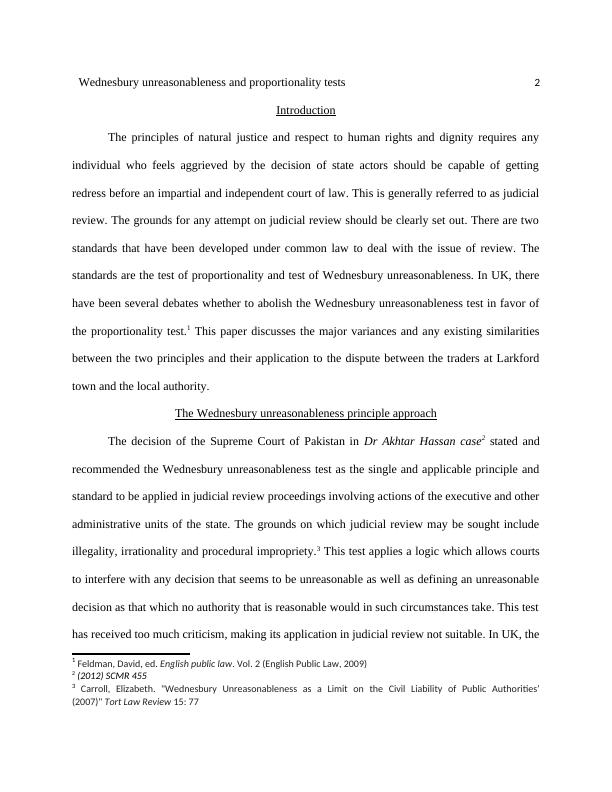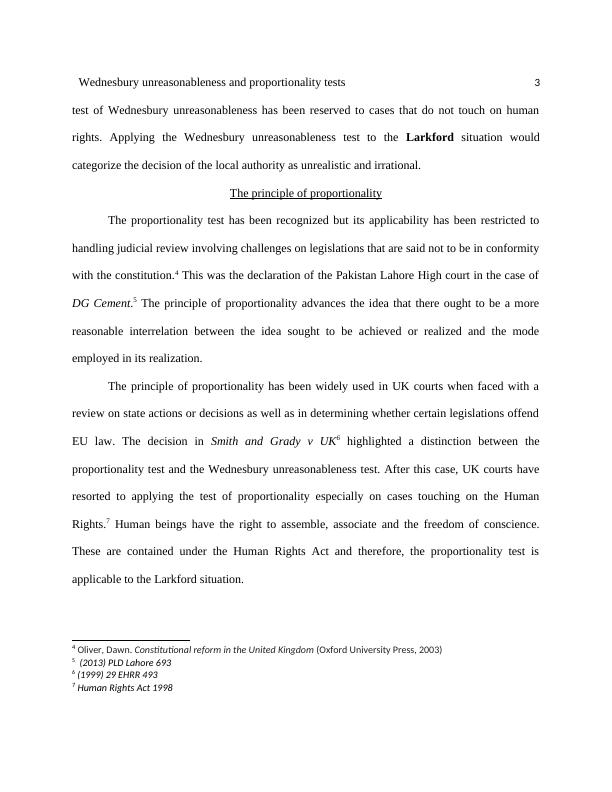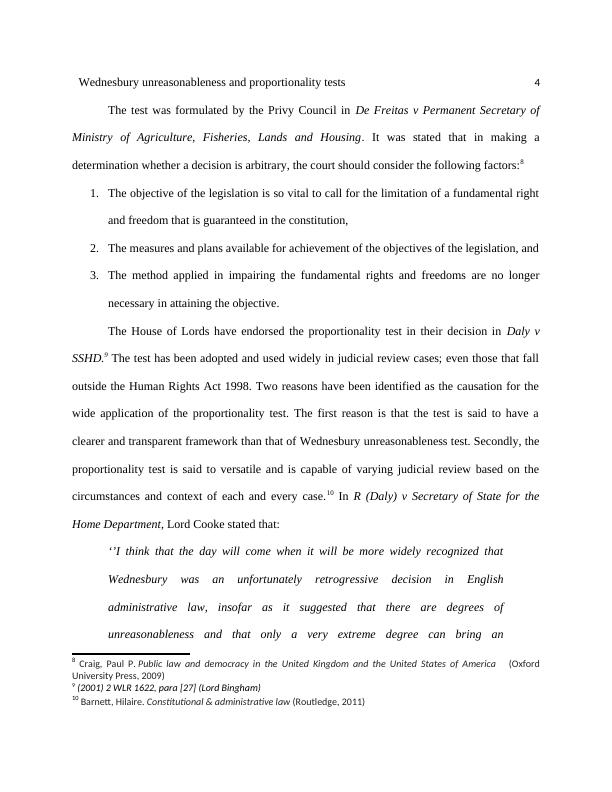Wednesbury Unreasonableness and Proportionality Tests
Added on 2023-06-12
11 Pages2862 Words478 Views
Wednesbury unreasonableness and proportionality tests 1
Name of Student
Name of Institution
Name of Instructotor
TOPIC II - PRINCIPLES OF JUDICIAL REVIEW
(Wednesbury unreasonableness and the principle of proportionality)
Compare and contrast the approaches of (a) Wednesbury unreasonableness and (b) the
principle of proportionality to this situation.
Which approach would you expect the court to adopt, and why?
Name of Student
Name of Institution
Name of Instructotor
TOPIC II - PRINCIPLES OF JUDICIAL REVIEW
(Wednesbury unreasonableness and the principle of proportionality)
Compare and contrast the approaches of (a) Wednesbury unreasonableness and (b) the
principle of proportionality to this situation.
Which approach would you expect the court to adopt, and why?

Wednesbury unreasonableness and proportionality tests 2
Introduction
The principles of natural justice and respect to human rights and dignity requires any
individual who feels aggrieved by the decision of state actors should be capable of getting
redress before an impartial and independent court of law. This is generally referred to as judicial
review. The grounds for any attempt on judicial review should be clearly set out. There are two
standards that have been developed under common law to deal with the issue of review. The
standards are the test of proportionality and test of Wednesbury unreasonableness. In UK, there
have been several debates whether to abolish the Wednesbury unreasonableness test in favor of
the proportionality test.1 This paper discusses the major variances and any existing similarities
between the two principles and their application to the dispute between the traders at Larkford
town and the local authority.
The Wednesbury unreasonableness principle approach
The decision of the Supreme Court of Pakistan in Dr Akhtar Hassan case2 stated and
recommended the Wednesbury unreasonableness test as the single and applicable principle and
standard to be applied in judicial review proceedings involving actions of the executive and other
administrative units of the state. The grounds on which judicial review may be sought include
illegality, irrationality and procedural impropriety.3 This test applies a logic which allows courts
to interfere with any decision that seems to be unreasonable as well as defining an unreasonable
decision as that which no authority that is reasonable would in such circumstances take. This test
has received too much criticism, making its application in judicial review not suitable. In UK, the
1 Feldman, David, ed. English public law. Vol. 2 (English Public Law, 2009)
2 (2012) SCMR 455
3 Carroll, Elizabeth. "Wednesbury Unreasonableness as a Limit on the Civil Liability of Public Authorities’
(2007)" Tort Law Review 15: 77
Introduction
The principles of natural justice and respect to human rights and dignity requires any
individual who feels aggrieved by the decision of state actors should be capable of getting
redress before an impartial and independent court of law. This is generally referred to as judicial
review. The grounds for any attempt on judicial review should be clearly set out. There are two
standards that have been developed under common law to deal with the issue of review. The
standards are the test of proportionality and test of Wednesbury unreasonableness. In UK, there
have been several debates whether to abolish the Wednesbury unreasonableness test in favor of
the proportionality test.1 This paper discusses the major variances and any existing similarities
between the two principles and their application to the dispute between the traders at Larkford
town and the local authority.
The Wednesbury unreasonableness principle approach
The decision of the Supreme Court of Pakistan in Dr Akhtar Hassan case2 stated and
recommended the Wednesbury unreasonableness test as the single and applicable principle and
standard to be applied in judicial review proceedings involving actions of the executive and other
administrative units of the state. The grounds on which judicial review may be sought include
illegality, irrationality and procedural impropriety.3 This test applies a logic which allows courts
to interfere with any decision that seems to be unreasonable as well as defining an unreasonable
decision as that which no authority that is reasonable would in such circumstances take. This test
has received too much criticism, making its application in judicial review not suitable. In UK, the
1 Feldman, David, ed. English public law. Vol. 2 (English Public Law, 2009)
2 (2012) SCMR 455
3 Carroll, Elizabeth. "Wednesbury Unreasonableness as a Limit on the Civil Liability of Public Authorities’
(2007)" Tort Law Review 15: 77

Wednesbury unreasonableness and proportionality tests 3
test of Wednesbury unreasonableness has been reserved to cases that do not touch on human
rights. Applying the Wednesbury unreasonableness test to the Larkford situation would
categorize the decision of the local authority as unrealistic and irrational.
The principle of proportionality
The proportionality test has been recognized but its applicability has been restricted to
handling judicial review involving challenges on legislations that are said not to be in conformity
with the constitution.4 This was the declaration of the Pakistan Lahore High court in the case of
DG Cement.5 The principle of proportionality advances the idea that there ought to be a more
reasonable interrelation between the idea sought to be achieved or realized and the mode
employed in its realization.
The principle of proportionality has been widely used in UK courts when faced with a
review on state actions or decisions as well as in determining whether certain legislations offend
EU law. The decision in Smith and Grady v UK6 highlighted a distinction between the
proportionality test and the Wednesbury unreasonableness test. After this case, UK courts have
resorted to applying the test of proportionality especially on cases touching on the Human
Rights.7 Human beings have the right to assemble, associate and the freedom of conscience.
These are contained under the Human Rights Act and therefore, the proportionality test is
applicable to the Larkford situation.
4 Oliver, Dawn. Constitutional reform in the United Kingdom (Oxford University Press, 2003)
5 (2013) PLD Lahore 693
6 (1999) 29 EHRR 493
7 Human Rights Act 1998
test of Wednesbury unreasonableness has been reserved to cases that do not touch on human
rights. Applying the Wednesbury unreasonableness test to the Larkford situation would
categorize the decision of the local authority as unrealistic and irrational.
The principle of proportionality
The proportionality test has been recognized but its applicability has been restricted to
handling judicial review involving challenges on legislations that are said not to be in conformity
with the constitution.4 This was the declaration of the Pakistan Lahore High court in the case of
DG Cement.5 The principle of proportionality advances the idea that there ought to be a more
reasonable interrelation between the idea sought to be achieved or realized and the mode
employed in its realization.
The principle of proportionality has been widely used in UK courts when faced with a
review on state actions or decisions as well as in determining whether certain legislations offend
EU law. The decision in Smith and Grady v UK6 highlighted a distinction between the
proportionality test and the Wednesbury unreasonableness test. After this case, UK courts have
resorted to applying the test of proportionality especially on cases touching on the Human
Rights.7 Human beings have the right to assemble, associate and the freedom of conscience.
These are contained under the Human Rights Act and therefore, the proportionality test is
applicable to the Larkford situation.
4 Oliver, Dawn. Constitutional reform in the United Kingdom (Oxford University Press, 2003)
5 (2013) PLD Lahore 693
6 (1999) 29 EHRR 493
7 Human Rights Act 1998

Wednesbury unreasonableness and proportionality tests 4
The test was formulated by the Privy Council in De Freitas v Permanent Secretary of
Ministry of Agriculture, Fisheries, Lands and Housing. It was stated that in making a
determination whether a decision is arbitrary, the court should consider the following factors:8
1. The objective of the legislation is so vital to call for the limitation of a fundamental right
and freedom that is guaranteed in the constitution,
2. The measures and plans available for achievement of the objectives of the legislation, and
3. The method applied in impairing the fundamental rights and freedoms are no longer
necessary in attaining the objective.
The House of Lords have endorsed the proportionality test in their decision in Daly v
SSHD.9 The test has been adopted and used widely in judicial review cases; even those that fall
outside the Human Rights Act 1998. Two reasons have been identified as the causation for the
wide application of the proportionality test. The first reason is that the test is said to have a
clearer and transparent framework than that of Wednesbury unreasonableness test. Secondly, the
proportionality test is said to versatile and is capable of varying judicial review based on the
circumstances and context of each and every case.10 In R (Daly) v Secretary of State for the
Home Department, Lord Cooke stated that:
‘’I think that the day will come when it will be more widely recognized that
Wednesbury was an unfortunately retrogressive decision in English
administrative law, insofar as it suggested that there are degrees of
unreasonableness and that only a very extreme degree can bring an
8 Craig, Paul P. Public law and democracy in the United Kingdom and the United States of America (Oxford
University Press, 2009)
9 (2001) 2 WLR 1622, para [27] (Lord Bingham)
10 Barnett, Hilaire. Constitutional & administrative law (Routledge, 2011)
The test was formulated by the Privy Council in De Freitas v Permanent Secretary of
Ministry of Agriculture, Fisheries, Lands and Housing. It was stated that in making a
determination whether a decision is arbitrary, the court should consider the following factors:8
1. The objective of the legislation is so vital to call for the limitation of a fundamental right
and freedom that is guaranteed in the constitution,
2. The measures and plans available for achievement of the objectives of the legislation, and
3. The method applied in impairing the fundamental rights and freedoms are no longer
necessary in attaining the objective.
The House of Lords have endorsed the proportionality test in their decision in Daly v
SSHD.9 The test has been adopted and used widely in judicial review cases; even those that fall
outside the Human Rights Act 1998. Two reasons have been identified as the causation for the
wide application of the proportionality test. The first reason is that the test is said to have a
clearer and transparent framework than that of Wednesbury unreasonableness test. Secondly, the
proportionality test is said to versatile and is capable of varying judicial review based on the
circumstances and context of each and every case.10 In R (Daly) v Secretary of State for the
Home Department, Lord Cooke stated that:
‘’I think that the day will come when it will be more widely recognized that
Wednesbury was an unfortunately retrogressive decision in English
administrative law, insofar as it suggested that there are degrees of
unreasonableness and that only a very extreme degree can bring an
8 Craig, Paul P. Public law and democracy in the United Kingdom and the United States of America (Oxford
University Press, 2009)
9 (2001) 2 WLR 1622, para [27] (Lord Bingham)
10 Barnett, Hilaire. Constitutional & administrative law (Routledge, 2011)

End of preview
Want to access all the pages? Upload your documents or become a member.
Related Documents
Proportionality Test in Administrative Lawlg...
|13
|3363
|246
Irish Administrative Law .lg...
|10
|3091
|334
Constitutional Law | Assignmentlg...
|11
|3078
|9
Role of Judicial Review in UK Constitution - Deskliblg...
|11
|3154
|321
Administrative Law Assignment 2022lg...
|25
|10257
|10
Administrative Law Assignmentlg...
|13
|2917
|116